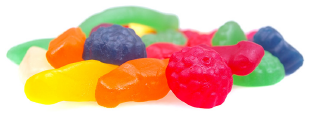This problem solving activity has an algebra focus.

Sonny has been given twice as many lollies as Sam, and Sylvia has three times as many lollies as Sam plus two lollies.
They are given the same number of lollies each day up to (and including) Friday.
Altogether, they are given 70 lollies.
How many lollies did Sam get on Monday?
- Solve multi-step problems that involve simple linear relationships.
- Write simple linear expressions.
- Devise and use problem-solving strategies to explore situations mathematically.
In this problem students are encouraged to to apply algebraic reasoning to find a solution. As they use a letter to represent an unknown amount, they are able to see how other unknowns can be expressed in relation to the first unknown, how an equation can be constructed, and how a solution can be found. This is a multi-step problem. Therefore, your students should have some knowledge of understanding and writing simple linear expressions to work successfully with this problem.
This is one of six related Number problems: Lollies! and More Lollies, Level 1; Sharing Lollies and Sharing More Lollies, Level 2; Lollies, Lollies, Lollies, Level 3; and Still More Lollies, which become more algebraic in their focus at each level.
The Problem
On Monday, Sam, Sonny and Sylvia share lollies that they've been given. Sonny has been given twice as many lollies as Sam, and Sylvia has three times as many lollies as Sam plus two lollies.
They are given the same number of lollies each day up to (and including) Friday. Altogether, they are given 70 lollies. How many lollies did Sam get on Monday?
Teaching Sequence
- Pose the problem to the class.
- Ask some simple questions to get the students thinking about the problem.
If Sam has ten lollies on Monday, how many have Sonny and Sylvia got on?
If Sonny has ten lollies how many do Sylvia and Sam have?
Ask the students to suggest equations they can use to express their answers. - Encourage students to use letters to express amount. Remind them of the meaning of the equals sign (i.e. the total on the left of the sign is the same as the total on the right). For example:
Sam = s
Sonny = 2s
Sylvia = 3s + 2 - Have students work on the problem. Encourage them to use equations in their written record of the solution.
- As the students work, ask:
What number operation have you selected? Why?
Tell me what this equation tells us.
Could you write the equation another way?
What operations have you used in your equation? Why?
Is there information given in the problem that is missing from your equation? How could you add it in? - Share solutions to the problem discussing the different approaches used.
Extension
Have students to make up similar problems for others to solve.
Solution
If Sam gets s lollies, Sonny gets 2s and Sylvia gets 3s + 2. On any one day they all get s + 2s + (3s + 2) = 6s + 2.
Over 5 days they get 5(6s + 2) = 30s + 10. This is 70. So the equation is 30s + 10 = 70. Taking 10 from both sides gives 30s = 60. Divide both sides by 30 to find s = 2. Sam got 2 lollies on Monday.
Alternatively, 70 lollies in five days is 70/5 = 14 in one day. Solve 6s + 2 = 14. So 6s = 12 and s = 2.